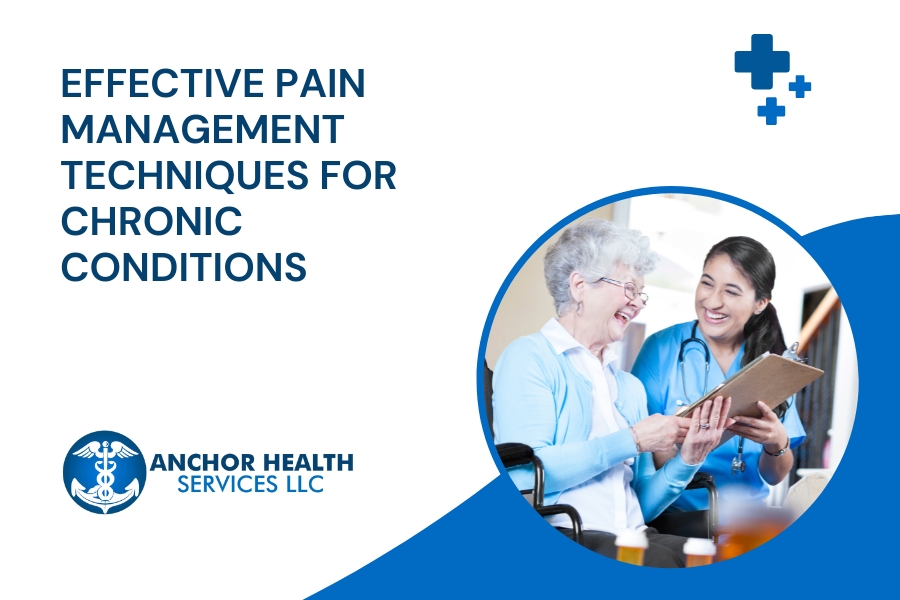Chronic pain can significantly impact a senior’s quality of life, limiting mobility, sleep, and overall well-being. Managing chronic pain requires a combination of medical treatments and non-medical strategies to help reduce discomfort and maintain independence. For seniors, having effective pain management solutions at home is essential to promoting long-term health and reducing the need for hospital visits.
In this blog, we’ll explore various pain management techniques that can help seniors manage chronic conditions more effectively at home.
The Importance of Pain Management at Home
Chronic conditions such as arthritis, neuropathy, and back pain can cause constant discomfort, making it difficult for seniors to enjoy daily activities. Effective pain management at home allows seniors to maintain their independence and continue engaging in activities they love without the burden of chronic pain.
In-home pain management also reduces the need for frequent hospital visits, allowing seniors to receive personalized care in a comfortable environment.
Medical Pain Management
For seniors living with chronic conditions, managing pain often involves a combination of medications and treatments. Common medical approaches include:
- Medications: Prescription pain relievers, anti-inflammatory drugs, and muscle relaxants can help manage pain levels. A caregiver can assist with medication setup and management to ensure the proper dosage and timing of these medications.
- Physical Therapy: A physical therapist can help seniors perform exercises to improve mobility and reduce pain. Regular physical therapy can strengthen muscles and improve joint flexibility, alleviating pain caused by chronic conditions such as arthritis or back problems. By focusing on specific areas of the body, physical therapy can reduce the strain on painful joints and tissues, leading to long-term pain relief.
- Nerve Blocks and Injections: In some cases, seniors may require more intensive treatments such as nerve blocks or corticosteroid injections to manage severe pain. These treatments can reduce inflammation and numb the nerves, providing longer-lasting pain relief than oral medications alone.
- Topical Treatments: Pain relief creams or gels can be applied to affected areas to reduce localized pain. These treatments are often used for joint or muscle pain and are a safer alternative for seniors who may have adverse reactions to oral medications.
Having access to these medical pain management strategies at home allows seniors to avoid the discomfort and inconvenience of frequent hospital visits while still receiving effective treatment.
Non-Medical Pain Management Techniques
In addition to medical interventions, several non-medical techniques can help seniors manage chronic pain. These techniques can often complement medical treatments and provide additional relief. Some of the most effective non-medical strategies include:
- Massage Therapy: Gentle massages can help reduce muscle tension and improve circulation, leading to pain relief. A caregiver or physical therapist can provide massages as part of the senior’s daily care routine to help ease discomfort.
- Heat and Cold Therapy: Applying heat or cold to affected areas can reduce inflammation and numb pain. Heat therapy is especially effective for relaxing tight muscles, while cold therapy helps reduce swelling in inflamed joints.
- Mindfulness and Relaxation Techniques: Meditation, deep breathing exercises, and other relaxation techniques can help seniors manage chronic pain by reducing stress and anxiety. These practices encourage the mind to focus away from the pain, promoting a sense of calm and relaxation.
- Exercise and Movement: Regular, low-impact exercise such as walking, swimming, or yoga can improve flexibility, strengthen muscles, and reduce the intensity of chronic pain. Caregivers can assist seniors in incorporating gentle exercise routines into their daily schedule to enhance pain management and overall well-being.
The Role of Caregivers in Pain Management
Caregivers are essential in helping seniors manage chronic pain at home. They provide physical assistance, emotional support, and companionship, making daily life more comfortable for seniors living with chronic pain. Caregivers can help with:
- Assisting with mobility and exercises that relieve pain
- Administering medications and treatments according to the care plan
- Offering emotional support and companionship to ease feelings of frustration or isolation related to chronic pain
- Monitoring for changes in the senior’s condition and adjusting care as needed
In-home caregivers also play a crucial role in communicating with healthcare providers, ensuring that the pain management plan is effective and adjusted as necessary.
Managing Pain from Chronic Conditions with Professional Support
Seniors dealing with chronic pain benefit greatly from having professional support at home. In addition to caregivers, home health aides and nurses can provide specialized care, including administering more complex pain management treatments such as injections or physical therapy. Regular nurse visits help ensure that the senior’s pain management plan is being followed and that any complications or changes in condition are addressed quickly.If you or a loved one is struggling with chronic pain, Anchor Health Services offers comprehensive pain management solutions to ensure comfort and improve quality of life. Our team of professionals is dedicated to providing personalized care tailored to each individual’s needs. Contact us today to learn more about how we can help manage pain effectively at home.


